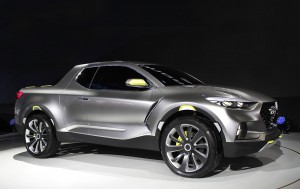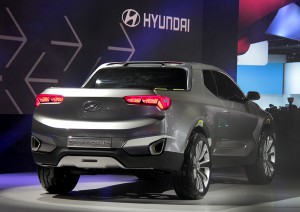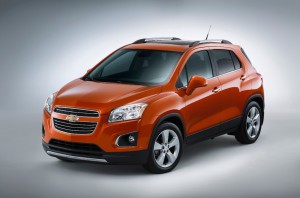
Hyundai said show-goers gave a thumbs up to the Santa Cruz concept, and now the company appears to be giving it a thumbs up too.
Look for Hyundai to add two important new models in the near future, including a production version of the unusual Santa Cruz pickup concept first unveiled at the North American International Auto Show in Detroit last January.
The automaker is also likely to add a new subcompact crossover to compete with the likes of the Chevrolet Trax and Jeep Renegade, said Dave Zuchowski, chief executive officer of Hyundai Motor North America. While final approval on both projects has yet to come from Hyundai headquarters in South Korea, Zuchowski said he is confident the carmaker will move ahead with both projects.
In addition, Hyundai also plans to show off a new version of the compact Elantra sedan during the Los Angeles Auto Show in November.
“There is a very high probability we get the approval of the truck soon,” said Zuchowski, during a conversation with reporters as Hyundai prepared for the rollout of the new Sonata hybrid.
(Hyundai Santa Cruz concept asks: when is a truck not a truck, Click Here for more.)
The Santa Cruz was one of the big surprises at this year’s Detroit Auto Show. Hyundai has long been known to be considering its options for a small pickup, but it took a very different approach from the traditional truck — and from the likes of the new Chevrolet Colorado and GMC Canyon models that have shown there is new life in the midsize pickup segment.
More car-like, the concept vehicle targeted young, so-called “Urban Adventurers” who are likely to lead an active lifestyle and want a place they can carry tools or toss dirty sportswear and gear, rather than inside their car or crossover. One or the more creative features was a built-in cargo bed extender.
According to Zuchowski, more than 90% of the potential buyers the company has surveyed like the Santa Cruz concept. “It’s proven very popular,” he said.
That’s good news for the Korean carmaker, as Hyundai’s top Korean executives have concluded that the key to future sales growth depends on expanding its truck line, Zuchowski said.
Separately, Hyundai is giving serious consideration to a small crossover that would compete with such new models as the Honda HR-V, Jeep Renegade and Chevrolet Trax.
“This is a growth segment,” he said. “We want a piece of it.”
(Click Here to check out the new 2016 Hyundai Tucson SUV.)
The executive said the U.S.operation had a chance to pick up an existing model already on sale in China but decided it was too conservative. The small crossover Hyundai is likely to offer in North America will be based off its own new platform and feature a more striking design, he promised.
Where the two new truck/crossover models will be built has not been determined. Hyundai has been struggling to find enough capacity to service the North American market in recent years.
The maker is in the process of finishing a study to determine its capacity needs, and, “There should be an announcement in the next 60 day to 90 days,” added Zuchowski, who said the automaker is expected to add capacity in the U.S. rather than Mexico where its sister company, Kia, has opted to build a new assembly plant.
(Click Here for details about a second Hyundai plant in the U.S.)
With a 6% sales increase this year, Zuchowski noted that Hyundai is more than holding its own on the car side of the business.
Hyundai utility vehicle sales also have grown by 6% this year, but they lag the overall market for trucks and SUVs, which has grown by more than 11%. Overall, trucks and utility vehicles now account for more than 56% of all vehicles sold in the U.S., according to IHS Automotive, as the shift towards trucks has accelerated this year with the drop in fuel prices.
According to Zuchowski, feedback on the Santa Cruz has been uniformly positive virtually everywhere but one particular region of the country. The one exception was Texas where buyers favor more traditional trucks. “But then Texas isn’t considered part of the U.S. is it?” he said with a wink.
(Paul A. Eisenstein contributed to this report.)



God that thing is FUGLY !
Every decade someone tries to bring back the El Camino. The Subaru Baja has come and gone and now this…I wish I could say I am horrified but I actually kind of like it.
What the heck is a Jeep Rendezvous??? U guys making stuff up?
Nope, just a pre-holiday brain fart. About to be corrected.
I LIKE THE NEW DESING, WICH I THINK IS GOOD FOR THE MARKETS YOU ARE AFTER, AND ALSO FOR OTHER MARKETS.
BUT I HAVE A SUGESTION, HOW ABOUT A TRUE SMALL PICKUP, LIKE THE 1200 CC.YOU USE TO BUILD BACK IN THE 70′ AND 8O’.
WHY? BECAUSE ALL LATIN AMERICAN YOUNG PEOPLE HAS GROW VERY VERY MUCH, AND THEY NEED “NEW TRANSPORTATION”, AT A LOWER PRICE. PROBABLY THE SAME IS FOR ASIA AND INDIA.
HERE IN GUATEMALA THE IMPORTATIONS OF USED VEHICLES IS 25% NEW AND 75% USED(USED MEANS CRASH VEHICLES)